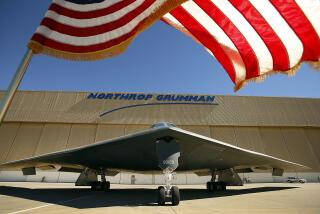Lockheed profit surges 23%, beats estimates
Lockheed Martin Corp., the U.S. government’s top contractor, said its first-quarter profit jumped 23 percent, topping analysts’ estimates even as federal budget cuts sapped sales.
Net income from continuing operations rose to $933 million, or $2.87 a share, from $761 million, or $2.33 a share, a year earlier, the company said today in a statement. That exceeded the $2.53-a-share estimate of 21 analysts surveyed by Bloomberg.
Lockheed’s earnings were aided by pension income and profit growth in four of the company’s five business units. The biggest increase in operating profit was in the Mission Systems and Training unit, which provides software and technology for government and commercial clients.
“We had some outright stronger performance than we had expected in the plan,” Bruce Tanner, the company’s chief financial officer, said on a conference call with analysts, referring to the Mission Systems unit.
The maker of the F-35 jet, the Pentagon’s most expensive weapons program, also boosted its full-year profit outlook. It now anticipates a profit from continuing operations of $10.50 to $10.80 a share, compared with $10.25 to $10.55 forecast in January. The contractor affirmed its earlier estimate of $44 billion to $45.5 billion in sales for 2014.
Sales declined 3.8 percent in the quarter to $10.7 billion. U.S. defense revenue has dropped about 10 percent during the last two years because of automatic federal spending cuts under a process known as sequestration, Tanner said earlier on a call with reporters.
“We had actually expected two years ago that 2014 would have been a growth year,” he said. “We’re not seeing that. We’re not seeing that because of the effects of sequestration.”
Lockheed shares fell 2 percent to $158.33 at 1:50 p.m. in New York, after rising 68 percent in the past 12 months, compared with a 21 percent gain in the Standard & Poor’s 500 Index.
Tanner said he expected Pentagon sales to continue to drop into 2015, though increases in international business should make up for almost all of the domestic decline. He said he anticipated international sales will account for almost 20 percent of revenue this year, up from 17 percent in 2013.
Lockheed is counting on growth from the F-35, the company’s largest program. It accounted for 16 percent of the company’s sales in 2013, up from 14 percent a year earlier, according to federal regulatory filings.
By 2019, the aircraft may account for a quarter of Lockheed’s sales, Tanner said.
Operating profit for the Mission Systems unit soared 24 percent in the quarter from a year earlier, followed by the Space Systems unit’s 10 percent boost. The company’s largest division, aeronautics, rose 3.7 percent, aided by C-130 transport aircraft and F-35 programs.
The aeronautics division was the only Lockheed segment with an increase in sales. It reported $3.39 billion in revenue in the first quarter, a 6.3 percent boost from a year earlier.
While Pentagon officials have said they will do their best to shield the F-35 from budget cuts, they outlined the limits of that protection in a report this month. The report said the Defense Department would be forced to cut 17 of the 343 fighters it planned to buy from fiscal 2016 through 2019 unless Congress repeals the automatic cuts.
Lockheed’s profit was helped by pension income of $86 million, which increased earnings by 16 cents a share in the quarter. A year earlier, Lockheed faced pension expenses of $121 million, reducing earnings by 23 cents a share.
The company said it spent $1.1 billion buying back 7 million shares, more than double the $461 million it spent on such repurchases in the first quarter of 2013, and increased its dividend payout to $444 million from $371 million.
In November, Lockheed announced it would cut 4,000 jobs and close some operations.
Lockheed is the first of the leading U.S. defense companies to report results for the quarter. Many military contractors’ sales are shrinking as the government slows spending and winds down the war in Afghanistan.
Federal budget reductions last year contributed to the fourth consecutive annual decline in government contracting, the longest stretch since Ronald Reagan was president.
In January, President Barack Obama signed a $1.1 trillion spending bill to fund the government through Sept. 30 and alleviate some of the cuts due to take effect under sequestration.






